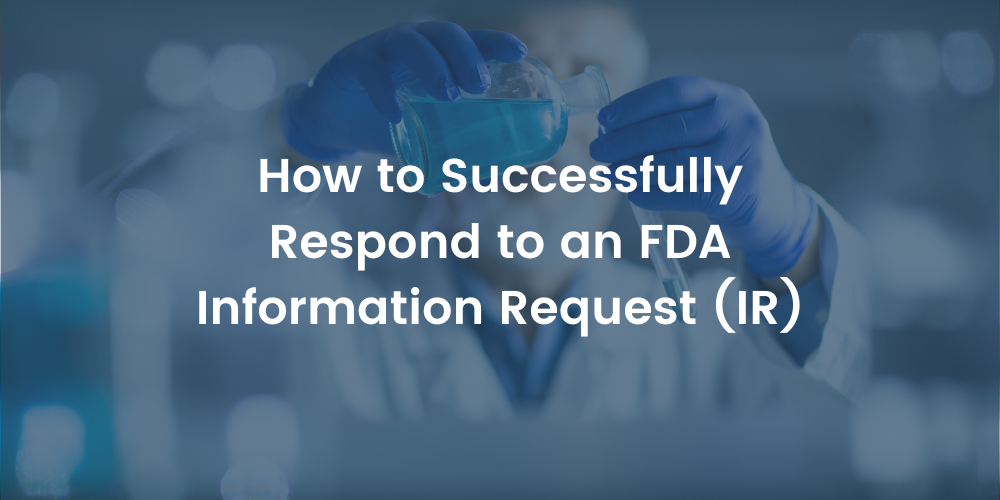How to Successfully Respond to an FDA Information Request (IR)
Getting your vaccine or therapeutic approved by the FDA is a significant accomplishment. But...
read Details

For thousands of years, tissue regeneration has been a topic of interest among the scientific world. The ancient civilizations of India and Greece were pioneering medical techniques that still impact the field today. Cleansing and debridement of wounds were commonplace, and there are reliable records from India dating back 1000 years describing skin grafting for facial reconstructions. The human regeneration potential was well-known also by the Greeks as early as the 8th Century BCE, as demonstrated by the myth of Prometheus: As punishment for offending Zeus, he was sentenced to 30,000 years of torture: Each day an eagle destroyed his liver, which then completely regenerated itself overnight to enable the process again the next morning. From these ancient origins we enter the modern era of regenerative medicine. [1][2]
Regenerative medicine is a major advancement in medical treatment used to replace or regenerate human tissue and organs that is based upon stem cell technology and tissue engineering. [3] No other cell in the body has the natural ability to repair damaged cells, generate new cell types or divide as rapidly as stem cells. [4]. Over the years, tissue engineering has gained momentum as a far-reaching scientific discipline – researchers have steadfastly pursued the development of new life-saving therapies. The field has grown from surgical implants such as artificial hips and bio-material scaffolds that support skin grafting to the discovery that launched it into a modern medical miracle: cell therapy. Cell therapy enabled major organ transplants, accelerating the innovation of bone marrow transplants for the treatment of leukemia, and invigorated cell biologists to investigate the possibility of creating, growing, and harvesting tissue in a laboratory setting. [5]
The positive impact that the versatility of stem cells has provided to modern medicine, particularly in the field of anticancer drug screening, regenerative medicine, immunotherapy, and targeted cancer treatment cannot be understated. Because of their unique properties, such as migration toward cancer cells, secretion of bioactive factors, and immunosuppression, stem cells promote tumor targeting and circumvent obstacles that have traditionally impeded gene therapy strategies. Monoclonal Antibodies (mAbs) which employ stem cells, function as novel delivery platforms by targeting both primary and metastatic cancer. [6]
Cancer stem cells are known to be responsible for tumor development, metastasis, and relapse after conventional therapies. Emergent therapeutic strategies in cancer have been focusing on the use of mAbs to stimulate an immune response against tumors, and since the inception of mAbs as cancer fighters, researchers are identifying and characterizing the stem cells of different tumor types. [7] Since mAbs should be able to facilitate earlier diagnosis by targeting specific antigens altered in cancer stem cells through molecular imaging, enable efficient destruction of tumor initiating cells, and improve clinical outcome for patients undergoing treatment. [4]
Monoclonal antibodies are an important part of cancer treatment and have opened the door for many innovations in the field of immunotherapy. Immunotherapies are a new type of cancer treatment that use extracted and genetically modified elements of a patient’s own cells to boost their immune system’s ability to work harder and smarter to attack and remove cancer cells. [8] [9]
The global immunotherapy market is expected to grow to USD 385.46 Billion by 2025 at a CAGR (compound annual growth rate) of 14.27% during the forecast period from 2018-2025. Major drivers that fuel the growth of the market are [10]:
An emerging innovation in immunotherapy treatment has changed the supply chain so that it literally begins and ends with the patient.
The supply chain begins with the process of apheresis – the extraction of a patient’s T cells from their blood. Often apheresis will also involve a parallel process involving the extraction of the patient’s tumor cells. After the cells are collected and given a unique identifier, they are moved through the storage, manufacturing, and transportation network. [11]
A major challenge with scaling out the production of immunotherapy is the transition from a flexible process at a single academic institution to a highly controlled process that can be implemented across many collection, manufacturing, and treatment sites over a variety of geographic regions and climates. [8]
Several types of immunotherapy treat life-threatening diseases today – all are highly specialized to each patient and require documented collection, prompt storage, and precision handling – presenting new challenges to the supply chain industry. Currently, no FDA guidelines exist for managing the patient sample collection, transportation, manufacturing, storage, and distribution of immunotherapies. [11] We will delve into this topic with our discussion of the process of autologous therapy collection next month.
With this exciting new frontier comes additional regulatory challenges because the complex manufacturing processes and their intermediates pose – along with a complete range of environmentally controlled conditions ranging from controlled room temperature (CRT) to refrigerated to deep-frozen cryogenic packaging systems. Managing these intricacies will be a challenge for today’s biopharmaceutical cold chain professionals.
We are going to explore these regulatory challenges in a series of posts to share with our industry our observations after numerous interactions with the regulatory agencies on the best approach for cold chain process validation for immunotherapy products. We wanted to start at the beginning: defining your cold chain network. Since the logistics network for immunotherapy products are the most complex in the biopharmaceutical industry and relatively new to most regulators, a detailed process map is an important foundation for discussion.
Next up: choosing your quality attributes to assess for cryogenic shipping temperatures. We hope you check back next month as we take the next step in our exploration of the cold chain challenges of regenerative medicine.
References
1. University of Nebraska Medical Center. History of Regenerative Medicine. Mary and DIck Holland Regenerative Medicine Program. [Online] [Cited: April 7, 2019.] This web article references another publication: Regenerative Medicine: Gustav Steinhoff, first Edition 2011 XXIV, Springer Publications. https://www.unmc.edu.
2. Sampognaa, Gianluca et al. Regenerative medicine: Historical roots and potential strategies in modern medicine. Science Direct. [Online] September 2015. [Cited: April 8, 2019.] Open Access. https://www.sciencedirect.com/science/article/pii/S2213879X1500053X.
3. Regenerative Medicine: Historical Roots and Potential Strategies in Modern Medicine. Science Direct. [Online] [Cited: April 7, 2019.] https://www.sciencedirect.com.
4. Mayo Clinic Staff. Stem Cells: What they are and what they do. Mayo Cinic. [Online] April 2, 2019. [Cited: April 7, 2019.] http://www.mayoclinic.org.
5. Napoli E, et al. Adv Exp Med Biol. 2018. Stem Cell Therapy: Repurposing Cell-Based Regenerative Medicine Beyond Cell Replacement. National Center for Biotechnology Information. [Online] [Cited: April 7, 2019.] http://ncbi.nlm.nih.gov.
6. Cheng-Liang Zhang, et al. Stem Cells in Cancer Therapy: Opportunities and Challenges. National Center for Biotechnology Information. [Online] Oncotarget, September 8, 2017. [Cited: April 7, 2019.] http://www.ncbi.nlm.nih.gov.
7. Okamoto OK, Perez JF. Targeting cancer stem cells with monoclonal antibodies: a new perspective in cancer therapy and diagnosis. National Centre for Biotechnology Information. [Online] [Cited: April 7, 2019.] https://www.ncbi.nlm.nih.gov/pubmed/18598221.
8. Modality Solutions. The Challenging Supply Chain & Logistics of Immunotherapy Drugs. Modality-Solutions.com. [Online] [Cited: March 25, 2019.] https://www.modality-solutions.com/the-challenging-supply-chain-logistics-of-immunotherapy-drugs/.
9. American Cancer Society. What is Cancer Immunotherapy? www.Cancer.org. [Online] [Cited: March 11, 2019.] https://www.cancer.org/treatment/treatments-and-side-effects/treatment-types/immunotherapy/what-is-immunotherapy.html.
10. MarketWatch. Global Immunotherapy Drugs Market to Grow at a CAGR over 14.27% from 2018 to 2025. MarketWatch. [Online] March 25, 2019. [Cited: April 8, 2019.] https://www.marketwatch.com/press-release/global-immunotherapy-drugs-market-to-grow-at-a-cagr-over-1427-from-2018-to-2025-2019-03-25?mod=mw_quote_news.
11. O’Donnell, Dan. The Cell Therapy Supply Chain: Logistical Considerations for Autologous Immunotherapies. BioProcess International. [Online] [Cited: March 25, 2019.] https://bioprocessintl.com/manufacturing/cell-therapies/the-cell-therapy-supply-chain-logistical-considerations-for-autologous-immunotherapies/.
Getting your vaccine or therapeutic approved by the FDA is a significant accomplishment. But...
read Details
This six-part article series explores Cold Chain Process Validation, addressing the multifaceted challenges and...
read Details
Are you aware of the open data files published online by the FDA? This...
read Details